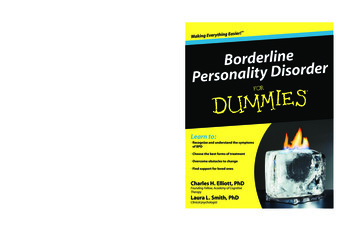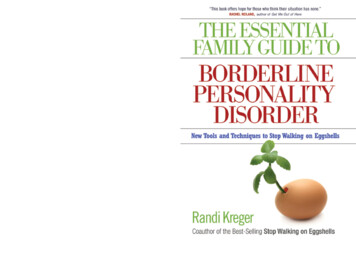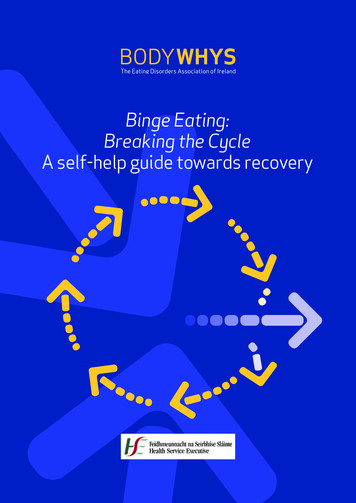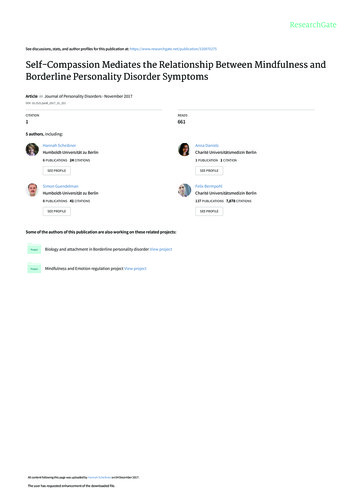
Transcription
est. spine .76”Psychology/Mental Healthg Easier!Making EverythinYour clear, compassionate guide tomanaging BPD — and living well Review the basics of BPD — discover the symptoms of BPDand the related emotional problems, as well as the cultural,biological, and psychological causes of the disease Understand what goes wrong — explore impulsivity, emotionaldysregulation, identity problems, relationship conflicts, blackand-white thinking, and difficulties in perception; and identifythe areas where you may need help Make the choice to change — find the right care provider,overcome common obstacles to change, set realistic goals, andimprove your physical and emotional state Evaluate treatments for BPD — learn about the currenttreatments that really work and develop a plan for addressingthe core symptoms of BPD If someone you love has BPD — see how to identify triggers,handle emotional upheavals, set clear boundaries, andencourage your loved one to seek therapy The major characteristics of BPD Who gets BPD — and why Recent treatment advances Illuminating case studies Strategies for calming emotionsand staying in control A discussion of medication options Ways to stay healthy duringtreatment Tips for explaining BPD to others Help for parents whose childexhibits symptomsBorderlinePersonality DisorderLooking for straightforward information on BorderlinePersonality Disorder? This easy-to-understand guide helpsthose who have BPD develop strategies for breakingthe destructive cycle. This book also aids loved ones inaccepting the disorder and offering support. Inside you’llfind authoritative details on the causes of BPD and proventreatments, as well as advice on working with therapists,managing symptoms, and enjoying a full life.Open the book and find: enilredroBredrosiDytilanosrPe Treatment options that work andthose you should avoidLearn to:Go to dummies.com for more! Recognize and understand the symptomsof BPD Choose the best forms of treatment Overcome obstacles to change Find support for loved ones 19.99 US / 23.99 CN / 14.99 UKCharles H. Elliott, PhD, and Laura L. Smith, PhD, are clinical psychologistswho specialize in training mental health professionals in the treatment ofadolescents and adults with personality disorders, as well as obsessivecompulsive disorder, anxiety, anger, and depression. They are thecoauthors of Depression For Dummies, Obsessive-Compulsive Disorder ForDummies, and Overcoming Anxiety For Dummies.Charles H. Elliott, PhDISBN 978-0-470-46653-7Founding Fellow, Academy of CognitiveTherapyElliottSmithLaura L. Smith, PhDClinical psychologist
01 466537-ffirs.indd iv6/24/09 8:49:20 PM
BorderlinePersonality DisorderFORDUMmIES‰by Charles H. Elliott, PhDLaura L. Smith, PhD01 466537-ffirs.indd i6/24/09 8:49:19 PM
Borderline Personality Disorder For Dummies Published byWiley Publishing, Inc.111 River St.Hoboken, NJ 07030-5774www.wiley.comCopyright 2009 by Wiley Publishing, Inc., Indianapolis, IndianaPublished by Wiley Publishing, Inc., Indianapolis, IndianaPublished simultaneously in CanadaNo part of this publication may be reproduced, stored in a retrieval system or transmitted in any form orby any means, electronic, mechanical, photocopying, recording, scanning or otherwise, except as permitted under Sections 107 or 108 of the 1976 United States Copyright Act, without either the prior writtenpermission of the Publisher, or authorization through payment of the appropriate per-copy fee to theCopyright Clearance Center, 222 Rosewood Drive, Danvers, MA 01923, (978) 750-8400, fax (978) 646-8600.Requests to the Publisher for permission should be addressed to the Permissions Department, John Wiley& Sons, Inc., 111 River Street, Hoboken, NJ 07030, (201) 748-6011, fax (201) 748-6008, or online at http://www.wiley.com/go/permissions.Trademarks: Wiley, the Wiley Publishing logo, For Dummies, the Dummies Man logo, A Reference for theRest of Us!, The Dummies Way, Dummies Daily, The Fun and Easy Way, Dummies.com, Making EverythingEasier, and related trade dress are trademarks or registered trademarks of John Wiley & Sons, Inc. and/or its affiliates in the United States and other countries, and may not be used without written permission.All other trademarks are the property of their respective owners. Wiley Publishing, Inc., is not associatedwith any product or vendor mentioned in this book.LIMIT OF LIABILITY/DISCLAIMER OF WARRANTY: THE CONTENTS OF THIS WORK ARE INTENDED TOFURTHER GENERAL SCIENTIFIC RESEARCH, UNDERSTANDING, AND DISCUSSION ONLY AND ARE NOTINTENDED AND SHOULD NOT BE RELIED UPON AS RECOMMENDING OR PROMOTING A SPECIFICMETHOD, DIAGNOSIS, OR TREATMENT BY PHYSICIANS FOR ANY PARTICULAR PATIENT. THE PUBLISHER AND THE AUTHOR MAKE NO REPRESENTATIONS OR WARRANTIES WITH RESPECT TO THEACCURACY OR COMPLETENESS OF THE CONTENTS OF THIS WORK AND SPECIFICALLY DISCLAIMALL WARRANTIES, INCLUDING WITHOUT LIMITATION ANY IMPLIED WARRANTIES OF FITNESS FOR APARTICULAR PURPOSE. IN VIEW OF ONGOING RESEARCH, EQUIPMENT MODIFICATIONS, CHANGESIN GOVERNMENTAL REGULATIONS, AND THE CONSTANT FLOW OF INFORMATION RELATING TOTHE USE OF MEDICINES, EQUIPMENT, AND DEVICES, THE READER IS URGED TO REVIEW AND EVALUATE THE INFORMATION PROVIDED IN THE PACKAGE INSERT OR INSTRUCTIONS FOR EACH MEDICINE, EQUIPMENT, OR DEVICE FOR, AMONG OTHER THINGS, ANY CHANGES IN THE INSTRUCTIONSOR INDICATION OF USAGE AND FOR ADDED WARNINGS AND PRECAUTIONS. READERS SHOULDCONSULT WITH A SPECIALIST WHERE APPROPRIATE. THE FACT THAT AN ORGANIZATION ORWEBSITE IS REFERRED TO IN THIS WORK AS A CITATION AND/OR A POTENTIAL SOURCE OF FURTHER INFORMATION DOES NOT MEAN THAT THE AUTHOR OR THE PUBLISHER ENDORSES THEINFORMATION THE ORGANIZATION OR WEBSITE MAY PROVIDE OR RECOMMENDATIONS IT MAYMAKE. FURTHER, READERS SHOULD BE AWARE THAT INTERNET WEBSITES LISTED IN THIS WORKMAY HAVE CHANGED OR DISAPPEARED BETWEEN WHEN THIS WORK WAS WRITTEN AND WHENIT IS READ. NO WARRANTY MAY BE CREATED OR EXTENDED BY ANY PROMOTIONAL STATEMENTSFOR THIS WORK. NEITHER THE PUBLISHER NOR THE AUTHOR SHALL BE LIABLE FOR ANY DAMAGESARISING HEREFROM.For general information on our other products and services, please contact our Customer CareDepartment within the U.S. at 877-762-2974, outside the U.S. at 317-572-3993, or fax 317-572-4002.For technical support, please visit www.wiley.com/techsupport.Wiley also publishes its books in a variety of electronic formats. Some content that appears in print maynot be available in electronic books.Library of Congress Control Number: Library of Congress Control Number is available from the publisher.ISBN: 978-0-470-46653-7Manufactured in the United States of America10 9 8 7 6 5 4 3 2 101 466537-ffirs.indd ii6/24/09 8:49:20 PM
About the AuthorsCharles H. Elliott, PhD, is a clinical psychologist and a Founding Fellow in theAcademy of Cognitive Therapy. He is also a member of the faculty at FieldingGraduate University. He specializes in the treatment of adolescents and adultswith obsessive-compulsive disorder, anxiety, anger, depression, and personality disorders. Dr. Elliott has authored many professional articles and bookchapters in the area of cognitive behavior therapies. He presents nationallyand internationally on new developments in the assessment and therapyof emotional disorders. Dr. Elliott is coauthor with Dr. Laura Smith of thefollowing books: Obsessive-Compulsive Disorder For Dummies, SeasonalAffective Disorder For Dummies, Anxiety & Depression Workbook For Dummies,Depression For Dummies, and Overcoming Anxiety For Dummies (Wiley),Hollow Kids: Recapturing the Soul of a Generation Lost to the Self-EsteemMyth (Prima Publishing), and Why Can’t I Be the Parent I Want to Be? (NewHarbinger). He also is a coauthor of the Behavioral Science Book Club selection Why Can’t I Get What I Want? How to Stop Making the Same Old Mistakesand Start Living a Life You Can Love (Davies-Black).Laura L. Smith, PhD, is a clinical psychologist who specializes in the assessment and treatment of adults and children with obsessive-compulsive disorder, as well as personality disorders, depression, anxiety, AD/HD, andlearning disorders. She is often asked to provide consultations to attorneys,school districts, and governmental agencies. She presents workshops oncognitive therapy and mental health issues to national and international audiences. Dr. Smith is a widely published author of articles and books to the profession and the public, including those coauthored with Dr. Elliott.Drs. Elliott and Smith are members of the New Mexico PsychologicalAssociation Board of Directors and affiliated training faculty at the CognitiveBehavioral Institute of Albuquerque. Their work has been featured invarious periodicals, including Family Circle, Parents, Child, and BetterHomes and Gardens, as well as popular publications like New York Post,Washington Times, Daily Telegraph (London), and Christian Science Monitor.They have been invited speakers at numerous conferences, including theNational Alliance for the Mentally Ill (NAMI), the Association for Behavioraland Cognitive Therapies, the International Association for CognitivePsychotherapy, and the National Association of School Psychologists. Theyhave appeared on television networks, such as CNN and Canada AM. In radio,they are often featured as experts on various NPR programs, as well as You,the Owner’s Manual Radio Show, Doctor Radio on Sirius Satellite Radio, theFranker Boyer Radio Show, and The Four Seasons Radio Show. They have committed their professional lives to making the science of psychology relevantand accessible to the public.Drs. Smith and Elliott are available for speaking engagements, expert interviews, and workshops. You can visit their Web site at www.PsychAuthors.com or their blog (“Anxiety & OCD Exposed”) at blogs.psychcentral.com/anxiety.01 466537-ffirs.indd iii6/24/09 8:49:20 PM
01 466537-ffirs.indd iv6/24/09 8:49:20 PM
DedicationWe dedicate this book to our children and their spouses: Alli, Brian, Grant,Nathan, Sara, and Trevor. And, of course, to our grandchildren: Alaina, Cade,Carter, and Lauren. Thanks for the excitement.Authors’ AcknowledgmentsWe’d like to thank our excellent editors at Wiley — our project editor, TimGallan, our acquisitions editor, Lindsay Lefevere, and our copy editor,Amanda Gillum — as well as our agents, Elizabeth and Ed Knappman.We also wish to thank our publicity and marketing team at Wiley, whichincluded David Hobson and Adrienne Fountain.We appreciate the hard work and dedication of Erika Hanson in keeping trackof our literature base. Thanks to Scott Love of Softek, LLC for his unwaveringcomputer and Web site support. Thanks to Trevor Wolfe for keeping us up onpop culture, social media, blogging, and tweeting on Twitter.We want to thank Deborah Wearn and Pamela Hargrove for finally figuringout how old Judy is (private, inside joke). Thanks to Sadie and Murphy fortaking us on much-needed walks.To Drs. Brad Richards and Jeanne Czajka from the Cognitive BehavioralInstitute of Albuquerque, thanks for including us on your affiliated trainingfaculty. To Dr. Brenda Wolfe, thanks for your enthusiastic support. We’re anxious to see your next book.Finally, we are especially grateful to our many clients, both those with BPDand those without. They helped us understand personality issues in general,as well as BPD. They also taught us about courage and persistence.01 466537-ffirs.indd v6/24/09 8:49:20 PM
Publisher’s AcknowledgmentsWe’re proud of this book; please send us your comments through our Dummies online registration form located at http://dummies.custhelp.com. For other comments, please contact ourCustomer Care Department within the U.S. at 877-762-2974, outside the U.S. at 317-572-3993, or fax317-572-4002.Some of the people who helped bring this book to market include the following:Acquisitions, Editorial, andMedia DevelopmentComposition ServicesProject Coordinator: Kristie ReesSenior Project Editor: Tim GallanLayout and Graphics: Christine WilliamsAcquisitions Editor: Lindsay LefevereCopy Editor: Amanda M. GillumProofreaders: Amanda Graham, Jessica Kramer,Nancy L. ReinhardtTechnical Reviewer: Lin AmesIndexer: Palmer Publishing ServicesEditorial Program Coordinator: Joe NiesenEditorial Manager: Michelle HackerEditorial Assistants: Jennette ElNaggar,David LuttonCover Photos: Diamond Sky ImagesCartoons: Rich Tennant(www.the5thwave.com)Publishing and Editorial for Consumer DummiesDiane Graves Steele, Vice President and Publisher, Consumer DummiesKristin Ferguson-Wagstaffe, Product Development Director, Consumer DummiesEnsley Eikenburg, Associate Publisher, TravelKelly Regan, Editorial Director, TravelPublishing for Technology DummiesAndy Cummings, Vice President and Publisher, Dummies Technology/General UserComposition ServicesDebbie Stailey, Director of Composition Service01 466537-ffirs.indd vi6/24/09 8:49:20 PM
Contents at a GlanceIntroduction . 1Part I: Mapping the Boundaries ofBorderline Personality Disorder . 7Chapter 1: Exploring Borderline Personality Disorder . 9Chapter 2: Defining Personality to Understand BPD . 19Chapter 3: Describing BPD . 27Chapter 4: Who Gets BPD and Why? . 51Part II: Taking Note of the Major BPD Symptoms . 65Chapter 5: Sensation Seeking and Self-Harm: The Impulsivity of BPD . 67Chapter 6: Explosive Feelings and Moods . 75Chapter 7: Missing Persons: Identity Problems and BPD . 83Chapter 8: Perceiving, Understanding, and Relating to Others . 91Chapter 9: BPD and Extreme Thinking . 101Chapter 10: Slipping Away from Reality. 113Part III: Making the Choice to Change . 121Chapter 11: Preparing to Conquer BPD . 123Chapter 12: Breaking Through Barriers to Change . 137Chapter 13: Explaining BPD to Others . 151Chapter 14: Taking Care of Yourself. 163Part IV: Treatments for BPD . 171Chapter 15: Inhibiting Impulsivity . 173Chapter 16: Calming the Storms Within . 189Chapter 17: Creating an Identity . 207Chapter 18: Putting Yourself in Other People’s Shoes . 217Chapter 19: Finding Shades of Gray: Changing Problematic Core Beliefs . 231Chapter 20: Considering Medication for BPD . 247Part V: Advice for People Who Care . 259Chapter 21: What to Do When Your Partner Has BPD . 261Chapter 22: Befriending People with BPD . 279Chapter 23: Parenting Children at Risk for BPD . 291Chapter 24: Advice for Adult Children of BPD Parents . 303Chapter 25: Advice for Therapists of People with BPD . 31102 466537-ftoc.indd vii6/24/09 8:50:58 PM
Part VI: The Part of Tens . 323Chapter 26: Ten Quick Ways to Settle Down . 325Chapter 27: Ten Ways to Say You’re Sorry. 329Chapter 28: Ten Things You Shouldn’t Do . 333Part VII: Appendixes . 337Appendix A: Resources for You . 339Appendix B: Forms to Help You Battle BPD . 343Index . 34902 466537-ftoc.indd viii6/24/09 8:50:58 PM
Table of ContentsIntroduction . 1About This Book . 1An Important Message to Our Readers. 2Conventions Used in This Book . 2What You’re Not to Read . 3Foolish Assumptions . 3How This Book Is Organized . 3Part I: Mapping the Boundaries ofBorderline Personality Disorder . 4Part II: Taking Note of the Major BPD Symptoms . 4Part III: Making the Choice to Change . 4Part IV: Treatments for BPD . 5Part V: Advice for People Who Care . 5Part VI: The Part of Tens . 5Part VII: Appendixes . 5Icons Used in This Book . 6Where to Go from Here . 6Part I: Mapping the Boundaries ofBorderline Personality Disorder . 7Chapter 1: Exploring Borderline Personality Disorder . . . . . . . . . . . . . .9Breaking Down Borderline Personality Disorder . 10Rocky relationships . 11Reckless responses. 11Yo-yo emotions . 12Convoluted thoughts . 12Exploring the Origins of BPD . 13Counting the Costs of BPD . 14Health costs . 14Financial and career-related costs. 15The toll on family and friends . 15Treating BPD . 16Psychotherapy . 16Medication . 17Helping People Who Have BPD . 1802 466537-ftoc.indd ix6/24/09 8:50:58 PM
xBorderline Personality Disorder For DummiesChapter 2: Defining Personality to Understand BPD . . . . . . . . . . . . . . .19Digging into Personality. 20Differentiating Healthy from Unhealthy. 20Flexibility: Rolling with the punches . 21Emotional regulation: Controlling what you express . 22Ability to delay gratification: Controlling impulses. 23Dependability: Doing what you say you’ll do . 23Interpersonal effectiveness: Having good relationships . 23Emotional resiliency: Bouncing back from tough breaks . 24Self-acceptance: Seeing yourself as you really are . 25Accurate perception of reality: Seeing the world as it is . 25Moderation: Avoiding extremes. 26Chapter 3: Describing BPD . . . . . . . . . . . . . . . . . . . . . . . . . . . . . . . . . . . . .27The Nine Symptoms of BPD . 271. Sensation seeking (impulsivity) . 282. Self-harm . 283. Roller coaster emotions . 294. Explosiveness . 295. Worries about abandonment . 296. Unclear and unstable self-concept . 297. Emptiness . 308. Up-and-down relationships. 309. Dissociation: Feeling out of touch with reality . 30Diagnosing BPD: Like Ordering from a Chinese Menu . 31Other Personality Disorders . 35The odd and eccentric . 35The dramatic and erratic . 38The anxious and fearful. 41Emotional Disorders That Accompany BPD . 44Anxiety . 45Mood disorders . 46Other emotional disorders . 48Chapter 4: Who Gets BPD and Why? . . . . . . . . . . . . . . . . . . . . . . . . . . . .51Considering Culture . 51Individualism: Emphasizing me versus we . 52Adolescence and BPD. 54Entitlement: Feeling too good . 55Family instability. 55Technology and its isolating effects . 56Childhood Challenges and the Increased Risk of BPD. 57Problematic parenting. 58Abuse and trauma . 61Separation and loss . 62Genetics and Biology: BPD in the Family Tree. 63Studying twins to find genetic causes . 63Bringing biology into the BPD equation. 6402 466537-ftoc.indd x6/24/09 8:50:58 PM
Table of ContentsxiPart II: Taking Note of the Major BPD Symptoms . 65Chapter 5: Sensation Seeking and Self-Harm:The Impulsivity of BPD . . . . . . . . . . . . . . . . . . . . . . . . . . . . . . . . . . . . . . . .67Living Dangerously: Impulsive Behavior . 67Hurting for Help . 69Types of self-harming acts . 70Why hurt yourself? . 71Suicide: Seeking the Ultimate Escape . 73A cry for help or an attempt at revenge? . 73Who’s at risk? . 73Chapter 6: Explosive Feelings and Moods. . . . . . . . . . . . . . . . . . . . . . . .75Emotions 101 . 75Primitive emotions . 76Thoughtful emotions . 78Emotions — Borderline Style . 79Struggling to recognize and express emotions . 81Having emotions about emotions . 81Chapter 7: Missing Persons: Identity Problems and BPD. . . . . . . . . . .83The Concept of Identity . 83Defining identity . 84Developing identity. 85Borderline Identity: Unstable and Fragile . 88Waffling identities . 88Responding to worries about identity . 89Chapter 8: Perceiving, Understanding, and Relating to Others . . . . . .91Standing in Other People’s Shoes. 92Understanding other people . 92Seeing yourself through other people’s eyes . 93Causing unintended hurt . 95Busting through Boundaries . 96Disrespecting partners and lovers . 98Slighting friends and co-workers . 98Straining relationships with helpers . 98Riding roughshod over kids . 99Chapter 9: BPD and Extreme Thinking . . . . . . . . . . . . . . . . . . . . . . . . . .101Understanding How You See the World . 101How schemas develop. 101Types of schemas . 102Why schemas are hard to change . 10302 466537-ftoc.indd xi6/24/09 8:50:58 PM
xiiBorderline Personality Disorder For DummiesBPD Schemas: No Middle Ground . 104Self-concept schemas . 105Relationship schemas . 108World schemas. 110Chapter 10: Slipping Away from Reality . . . . . . . . . . . . . . . . . . . . . . . .113Discovering Dissociation . 113Feeling Paranoid or Delusional . 115Having Hallucinations . 117When You Have BPD and Feel Crazy. 119Part III: Making the Choice to Change . 121Chapter 11: Preparing to Conquer BPD . . . . . . . . . . . . . . . . . . . . . . . . .123Exploring BPD Treatment Settings . 124Working individually with a therapist . 124Giving groups a chance . 124Spending more time in treatment: Partial hospitalization . 125Needing more care: Inpatient psychiatric wards. 125Combining and changing treatments . 126Researching the Treatment Strategies That Work for BPD. 126Choosing a Mental Health Professional . 129Primary healthcare providers .
Dummies, and Overcoming Anxiety For Dummies. Psychology/Mental Health 19.99 US / 23.99 CN / 14.99 UK ISBN 978-0-470-46653-7 Go to dummies.com for more! Your clear, compassionate guide to managing BPD — and living well Looking for straightforward information on Borderline










